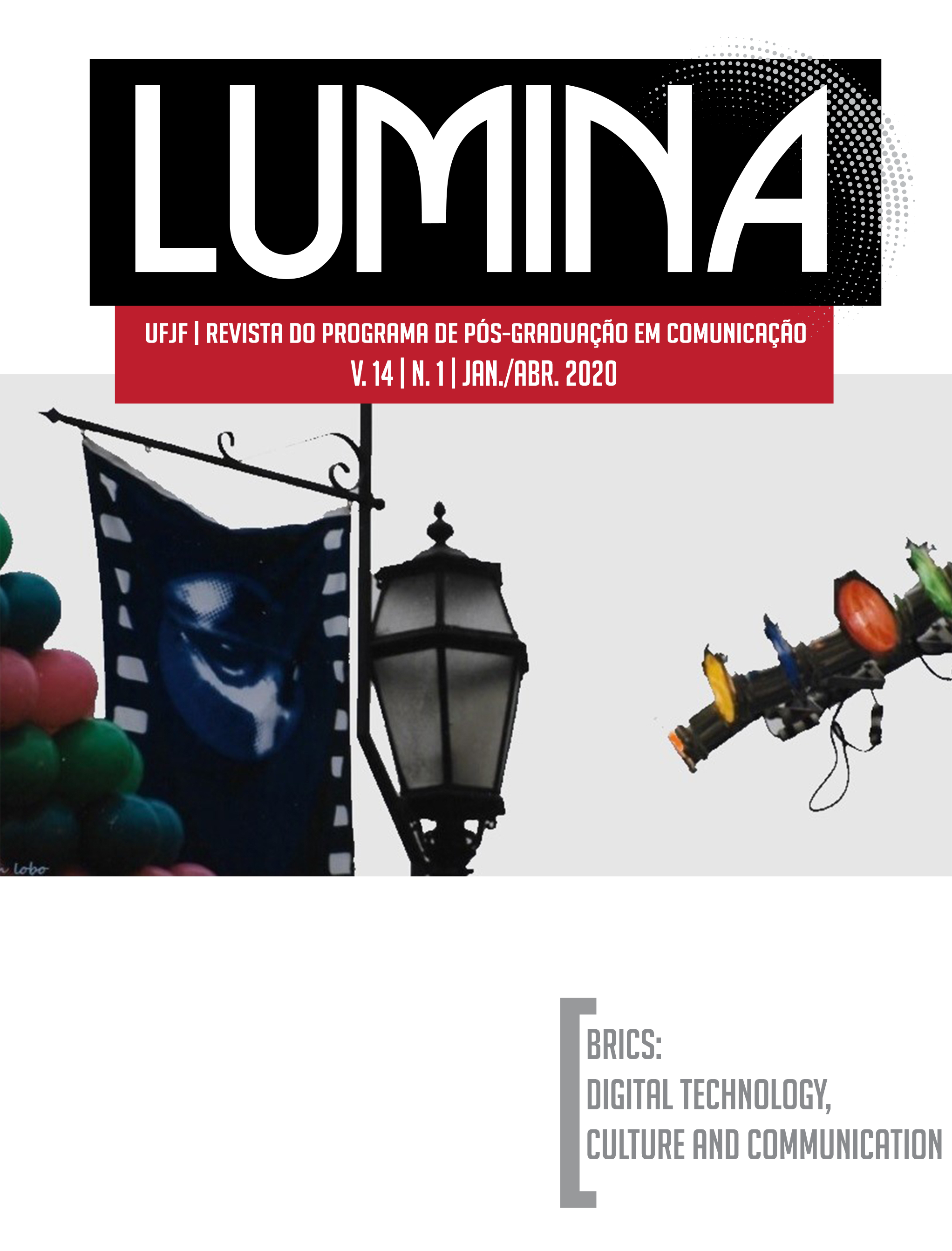The Soft Power of India
DOI:
https://doi.org/10.34019/1981-4070.2020.v14.30137Palavras-chave:
Soft Power, India, Diaspora, Democracy, Digital India, BRICSResumo
India’s soft power is on the rise, in parallel with its economic power as one of the fastest growing major economies in the world. This chapter discusses India’s soft power within four domains: firstly, the democratic strengths of India, a particular distinction among the BRICS countries. As the world’s largest democracy, India has retained and arguably strengthened democracy in a multi-lingual, multi-racial and multi-religious society. The second domain examines the diasporic dimension of India’s international presence, increasingly viewed by Indian government and corporates as a vital resource for its soft power. As the world’s largest English-language speaking diaspora, the Indian presence is visible across the globe. The third domain focuses on the emergence of an Indian internet – part of the Indian government’s ‘Digital India’ initiative, launched in 2015 - and its potential for becoming the world’s largest ‘open’ internet. The chapter argues that, with the government of Prime Minister Narendra Modi the push for digital commerce and communication is likely to increase. Already home to the world’s second largest internet population, its creative and cultural industries, notably Bollywood, have the potential to circulate across various digital domains, resulting in globalized production, distribution and consumption practices. However, the chapter argues that these three domains of soft power will remain ineffective until India is able to eliminate its pervasive and persistent poverty, afflicting large number of its citizens.
Downloads
Metrics
Referências
ACHARYA, Amitav. The End of American World Order. Second edition, Cambridge: Polity, 2018.
ATHIQUE, Adrian. Soft power, culture and modernity: Responses to Bollywood films in Thailand and the Philippines. International Communication Gazette, v.81, n. 5, p.470-489, 2019. Disponível em: <https://journals.sagepub.com/doi/abs/10.1177/1748048518802234>. Acesso em: 7 abr. 2020.
BLAREL, Nicolas. India’s Soft Power: From Potential to Reality?. In IDEAS Reports – Special Reports, KITCHEN, Nicholas (ed.). SR010. LSE IDEAS, Londres: London School of Economics and Political Science, 2012.
CHAKRAVORTY, Sanjoy; KAPUR, Devesh; SINGH, Nirvikar. The Other One Percent: Indians in America. Nova York: Oxford University Press, 2017.
CULL, Nicholas. Public Diplomacy: Foundations for Global Engagement in the Digital Age. Cambridge: Polity, 2019.
DRÈZE, Jean; SEN, Amartya. An Uncertain Glory: India and its Contradictions. Princeton: Princeton University Press, 2013.
FICCI/KPMG REPORT. Media for the Masses: The Promise Unfolds - FICCI/KPMG Indian Media and Entertainment Industry Report 2017. Mumbai: Federation of Indian Chambers of Commerce and Industry/KPMG India, 2017.
FICCI/EY Report. Re-imagining India’s M&E Sector. Mumbai: Federation of Indian Chambers of Commerce and Industry/EY India, 2018.
GAUTAM, Aavriti; DROOGAN, Julian. Yoga soft power: How flexible is the posture?. The Journal of International Communication, v. 24, n.1, p. 18-36, 2018. Disponível em: <https://www.tandfonline.com/doi/abs/10.1080/13216597.2017.1388829?journalCode=rico20>. Acesso em: 8 abr. 2020.
GERA ROY, Anjali (ed.). The Magic of Bollywood: At Home and Abroad. Nova Delhi: Sage, 2012.
GOVERNMENT OF INDIA. Annual Report of the Ministry of External Affairs. Nova Delhi: Government of India Press, 2020.
IMF. World Economic Outlook, April. Washington: International Monetary Fund, 2019.
KAPUR, Davesh. Diaspora, Development, and Democracy: The Domestic Impact of International Migration from India. Princeton: Princeton University Press, 2010.
KOHLI, Atul. Poverty Amid Plenty in the New India. Cambridge: Cambridge University Press, 2012.
KUGIEL, Patryk. India’s Soft Power: Foreign Policy Strategy. Londres Routledge, 2017.
MAZUMDAR, Arijit. India’s soft power diplomacy under the Modi administration: Buddhism, diaspora and yoga. Asian Affairs, v.49, n. 3, p. 468-491, 2018. Disponível em: <https://www.tandfonline.com/doi/abs/10.1080/03068374.2018.1487696>. Acesso em: 7 abr. 2020.
MUKHERJEE, Rohan. The false promise of India’s soft power. Geopolitics, History, and International Relations, v. 6, n. 1,p. 46-62, 2014. Disponível em: <https://www.researchgate.net/publication/256057428_The_False_Promise_of_India's_Soft_Power>. Acesso em: 7 abr. 2020.
NYE, Joseph. Soft Power: The Means to Success in World Politics, Nova York: Public Affairs, 2004.
PAREL, Anthony. Pax Gandhiana: The Political Philosophy of Mahatma Gandhi.
Nova York: Oxford University Press, 2016.
PUNATHAMBEKAR, Aswin. From Bombay to Bollywood: The Making of a Global Media Industry. Nova York: New York University Press, 2013.
RANA, Kishan. India’s Diaspora Diplomacy. Hague Journal of Diplomacy, v. 4, n. 3, p. 361-72, 2009. Disponível em: <https://brill.com/view/journals/hjd/4/3/article-p361_6.xml?language=en>. Acesso em: 7 abr. 2020.
SCHAEFER, David; KARAN, Kavita (eds.). Bollywood and Globalization: The Global Power of Popular Hindi Cinema. Londres: Routledge, 2013.
SEN, Amartya. The Argumentative Indian. Londres: Penguin, 2005.
SWAMINATHAN, Roopa. Bollywood Boom: India’s Rise as a Soft Power. Nova Delhi: Penguin, 2017.
TANDON, Aakriti. Transforming the Unbound Elephant to the Lovable Asian Hulk: Why is Modi Leveraging India’s Soft Power? The Round Table: The Commonwealth Journal of International Affairs, v.105, n. 1, p. 57-65, 2016. Disponível em: < https://bit.ly/2VrDnrd >. Acesso em: 7 abr. 2020.
THAROOR, Shashi. India as a Soft Power. India International Centre Quarterly, v. 35, n.1, p. 32-45, 2008. Disponível em: < https://bit.ly/3c9a6s1>. Acesso em: 7 abr. 2020.
THAROOR, Shashi. Pax Indica: India and the World of the Twenty-first Century. Nova Delhi: Pengui, 2012.
THUSSU, Daya Kishan. Communicating India’s Soft Power: Buddha to Bollywood. Nova York: Palgrave-Macmillan/Nova Delhi: Sage, 2013/2016.
YAU, Elaine. How Bollywood hit the mark in China. South China Morning Post, dez. 2018.
Downloads
Publicado
Como Citar
Edição
Seção
Licença
Autores que publicam nesta revista concordam com os seguintes termos:
- Autores mantém os direitos autorais e concedem à revista o direito de primeira publicação, com o trabalho simultaneamente licenciado sob a Licença Creative Commons Attribution que permite o compartilhamento do trabalho com reconhecimento da autoria e publicação inicial nesta revista.
- Autores têm autorização para assumir contratos adicionais separadamente, para distribuição não-exclusiva da versão do trabalho publicada nesta revista (ex.: publicar em repositório institucional ou como capítulo de livro), com reconhecimento de autoria e publicação inicial nesta revista.
- Autores têm permissão e são estimulados a publicar e distribuir seu trabalho online (ex.: em repositórios institucionais ou na sua página pessoal) a qualquer ponto antes ou durante o processo editorial, já que isso pode gerar alterações produtivas, bem como aumentar o impacto e a citação do trabalho publicado (Veja O Efeito do Acesso Livre).





